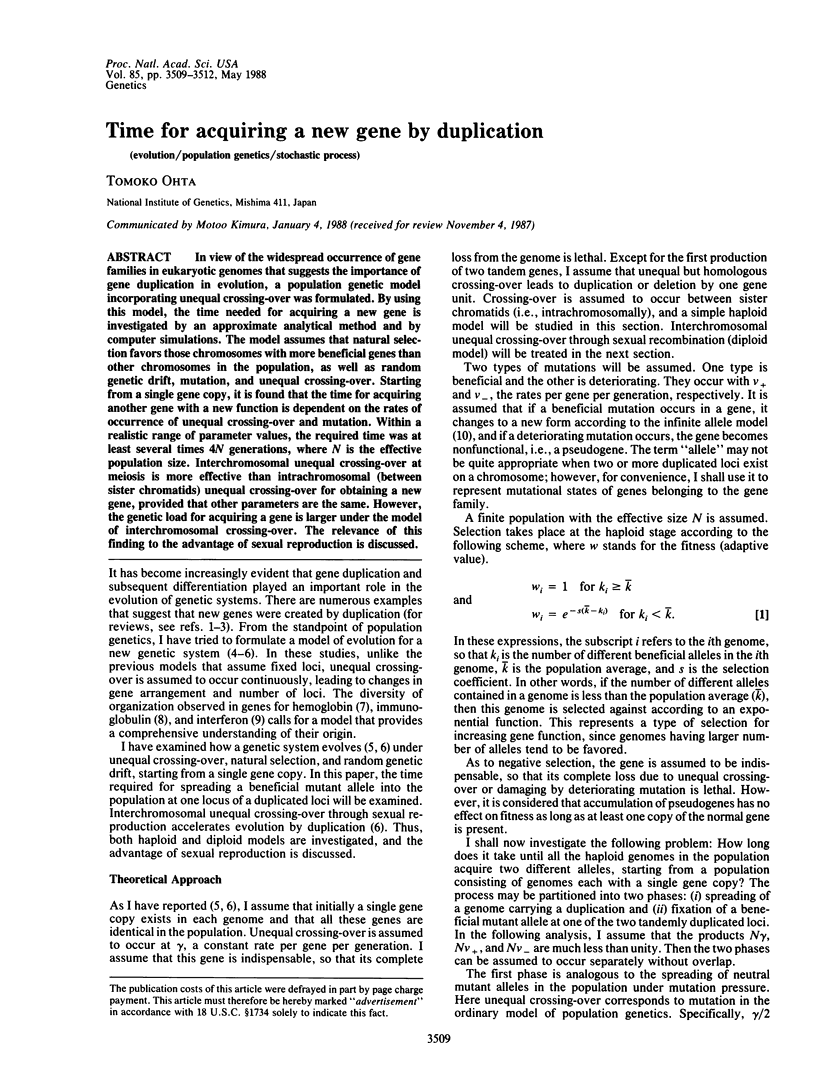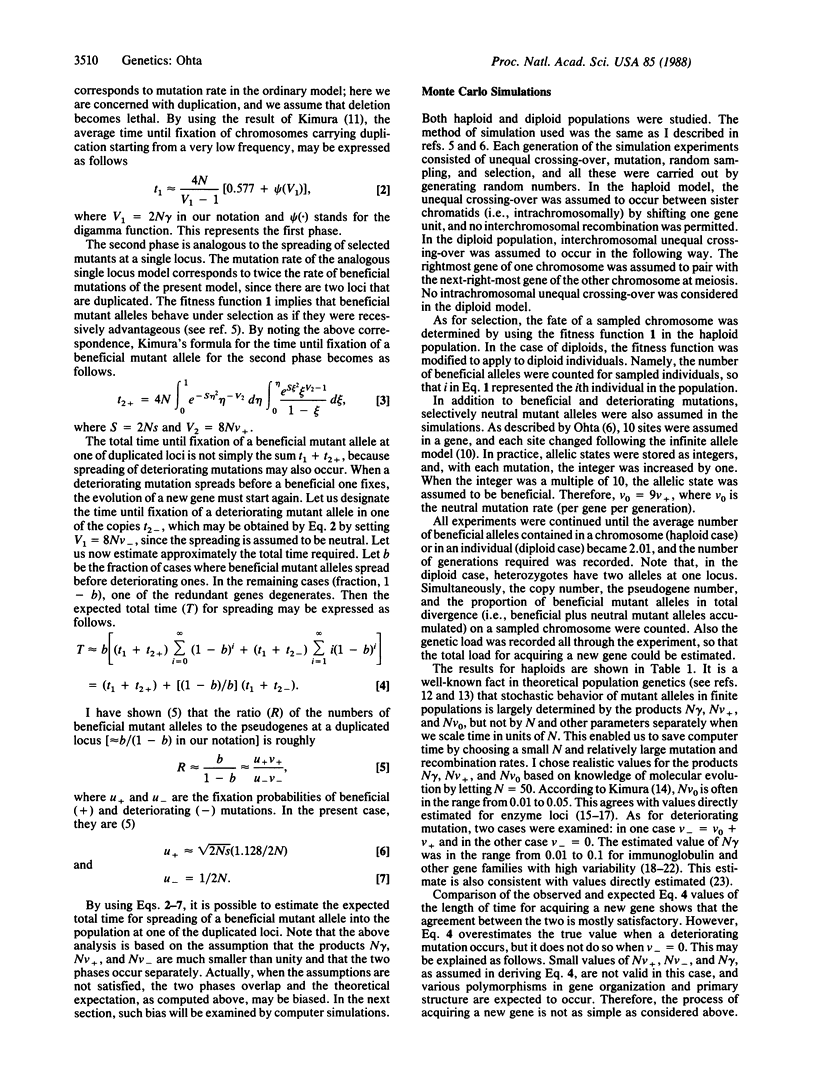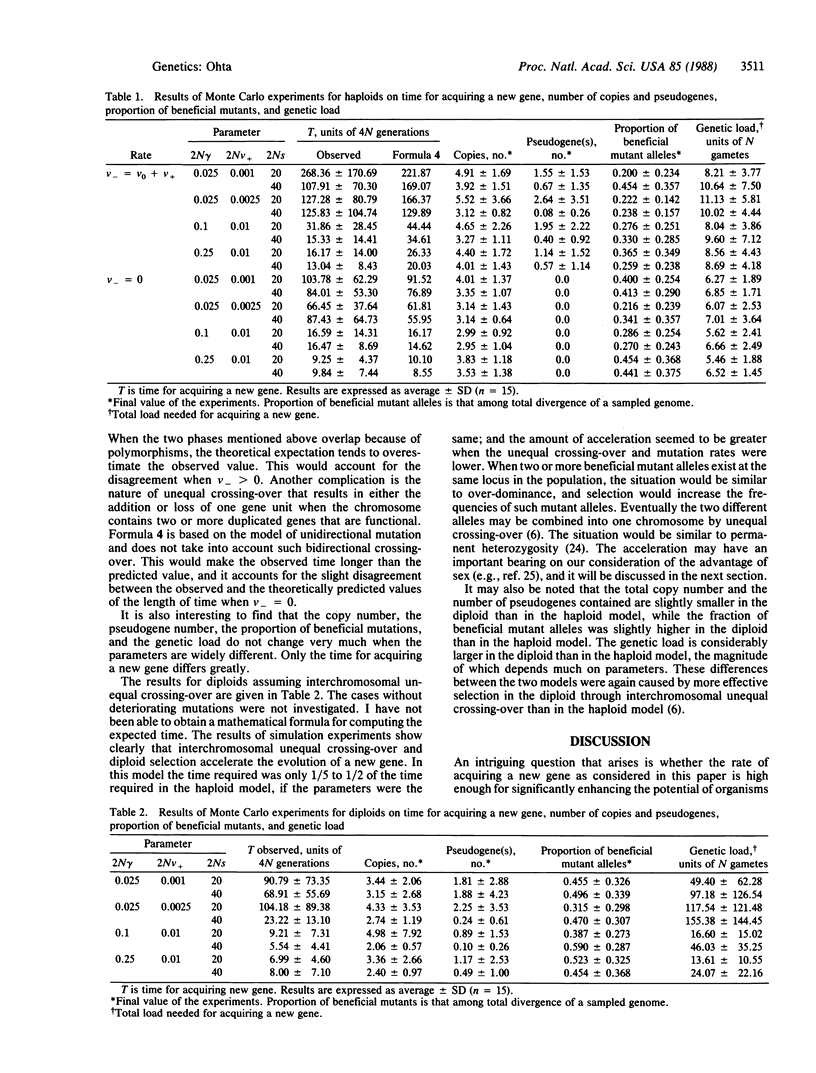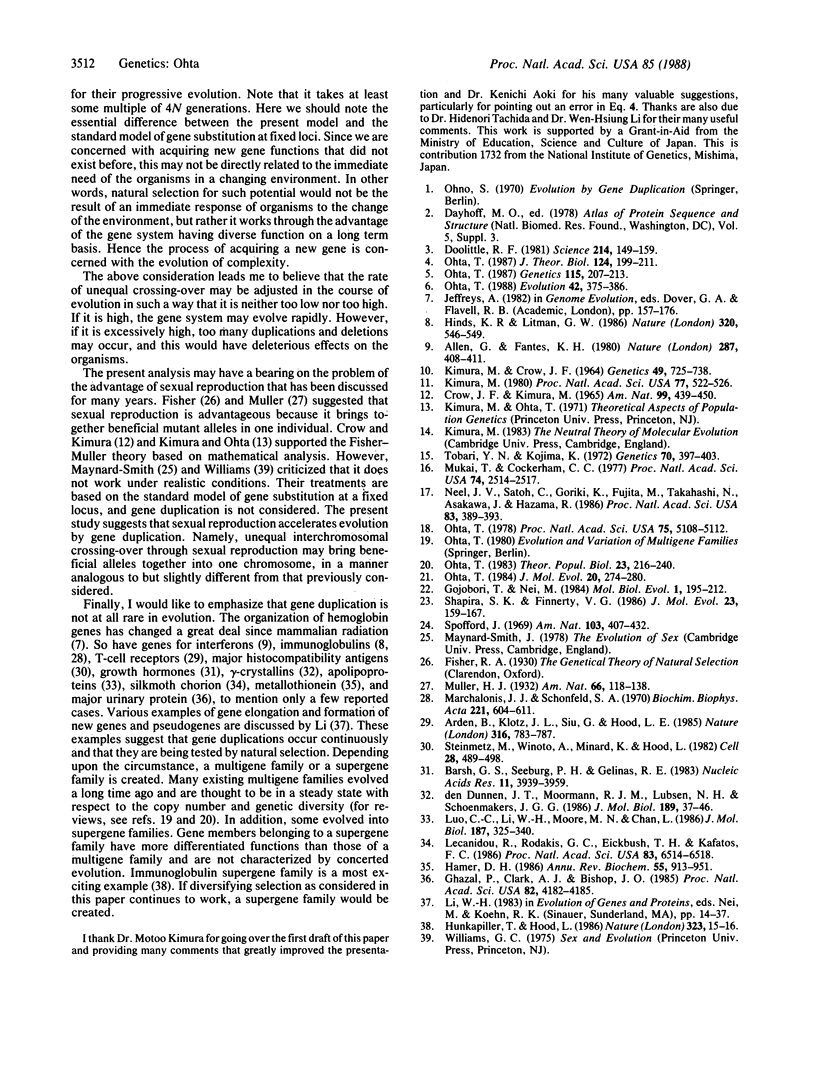Abstract
In view of the widespread occurrence of gene families in eukaryotic genomes that suggests the importance of gene duplication in evolution, a population genetic model incorporating unequal crossing-over was formulated. By using this model, the time needed for acquiring a new gene is investigated by an approximate analytical method and by computer simulations. The model assumes that natural selection favors those chromosomes with more beneficial genes than other chromosomes in the population, as well as random genetic drift, mutation, and unequal crossing-over. Starting from a single gene copy, it is found that the time for acquiring another gene with a new function is dependent on the rates of occurrence of unequal crossing-over and mutation. Within a realistic range of parameter values, the required time was at least several times 4N generations, where N is the effective population size. Interchromosomal unequal crossing-over at meiosis is more effective than intrachromosomal (between sister chromatids) unequal crossing-over for obtaining a new gene, provided that other parameters are the same. However, the genetic load for acquiring a gene is larger under the model of interchromosomal crossing-over. The relevance of this finding to the advantage of sexual reproduction is discussed.
Full text
PDF



Selected References
These references are in PubMed. This may not be the complete list of references from this article.
- Allen G., Fantes K. H. A family of structural genes for human lymphoblastoid (leukocyte-type) interferon. Nature. 1980 Oct 2;287(5781):408–411. doi: 10.1038/287408a0. [DOI] [PubMed] [Google Scholar]
- Arden B., Klotz J. L., Siu G., Hood L. E. Diversity and structure of genes of the alpha family of mouse T-cell antigen receptor. 1985 Aug 29-Sep 4Nature. 316(6031):783–787. doi: 10.1038/316783a0. [DOI] [PubMed] [Google Scholar]
- Barsh G. S., Seeburg P. H., Gelinas R. E. The human growth hormone gene family: structure and evolution of the chromosomal locus. Nucleic Acids Res. 1983 Jun 25;11(12):3939–3958. doi: 10.1093/nar/11.12.3939. [DOI] [PMC free article] [PubMed] [Google Scholar]
- Doolittle R. F. Similar amino acid sequences: chance or common ancestry? Science. 1981 Oct 9;214(4517):149–159. doi: 10.1126/science.7280687. [DOI] [PubMed] [Google Scholar]
- Ghazal P., Clark A. J., Bishop J. O. Evolutionary amplification of a pseudogene. Proc Natl Acad Sci U S A. 1985 Jun;82(12):4182–4185. doi: 10.1073/pnas.82.12.4182. [DOI] [PMC free article] [PubMed] [Google Scholar]
- Gojobori T., Nei M. Concerted evolution of the immunoglobulin VH gene family. Mol Biol Evol. 1984 Feb;1(2):195–212. doi: 10.1093/oxfordjournals.molbev.a040311. [DOI] [PubMed] [Google Scholar]
- Hamer D. H. Metallothionein. Annu Rev Biochem. 1986;55:913–951. doi: 10.1146/annurev.bi.55.070186.004405. [DOI] [PubMed] [Google Scholar]
- Hinds K. R., Litman G. W. Major reorganization of immunoglobulin VH segmental elements during vertebrate evolution. Nature. 1986 Apr 10;320(6062):546–549. doi: 10.1038/320546a0. [DOI] [PubMed] [Google Scholar]
- Hunkapiller T., Hood L. The growing immunoglobulin gene superfamily. Nature. 1986 Sep 4;323(6083):15–16. doi: 10.1038/323015a0. [DOI] [PubMed] [Google Scholar]
- KIMURA M., CROW J. F. THE NUMBER OF ALLELES THAT CAN BE MAINTAINED IN A FINITE POPULATION. Genetics. 1964 Apr;49:725–738. doi: 10.1093/genetics/49.4.725. [DOI] [PMC free article] [PubMed] [Google Scholar]
- Kimura M. Average time until fixation of a mutant allele in a finite population under continued mutation pressure: Studies by analytical, numerical, and pseudo-sampling methods. Proc Natl Acad Sci U S A. 1980 Jan;77(1):522–526. doi: 10.1073/pnas.77.1.522. [DOI] [PMC free article] [PubMed] [Google Scholar]
- Lecanidou R., Rodakis G. C., Eickbush T. H., Kafatos F. C. Evolution of the silk moth chorion gene superfamily: gene families CA and CB. Proc Natl Acad Sci U S A. 1986 Sep;83(17):6514–6518. doi: 10.1073/pnas.83.17.6514. [DOI] [PMC free article] [PubMed] [Google Scholar]
- Luo C. C., Li W. H., Moore M. N., Chan L. Structure and evolution of the apolipoprotein multigene family. J Mol Biol. 1986 Feb 5;187(3):325–340. doi: 10.1016/0022-2836(86)90436-5. [DOI] [PubMed] [Google Scholar]
- Marchalonis J. J., Schonfeld S. A. Polypeptide chain structure of sting ray immunoglobulin. Biochim Biophys Acta. 1970 Dec 22;221(3):604–611. doi: 10.1016/0005-2795(70)90232-1. [DOI] [PubMed] [Google Scholar]
- Mukai T., Cockerham C. C. Spontaneous mutation rates at enzyme loci in Drosophila melanogaster. Proc Natl Acad Sci U S A. 1977 Jun;74(6):2514–2517. doi: 10.1073/pnas.74.6.2514. [DOI] [PMC free article] [PubMed] [Google Scholar]
- Neel J. V., Satoh C., Goriki K., Fujita M., Takahashi N., Asakawa J., Hazama R. The rate with which spontaneous mutation alters the electrophoretic mobility of polypeptides. Proc Natl Acad Sci U S A. 1986 Jan;83(2):389–393. doi: 10.1073/pnas.83.2.389. [DOI] [PMC free article] [PubMed] [Google Scholar]
- Ohta T. A model of evolution for accumulating genetic information. J Theor Biol. 1987 Jan 21;124(2):199–211. doi: 10.1016/s0022-5193(87)80262-x. [DOI] [PubMed] [Google Scholar]
- Ohta T. On the evolution of multigene families. Theor Popul Biol. 1983 Apr;23(2):216–240. doi: 10.1016/0040-5809(83)90015-1. [DOI] [PubMed] [Google Scholar]
- Ohta T. Population genetics theory of concerted evolution and its application to the immunoglobulin V gene tree. J Mol Evol. 1984;20(3-4):274–280. doi: 10.1007/BF02104733. [DOI] [PubMed] [Google Scholar]
- Ohta T. Sequence variability of immunoglobulins considered from the standpoint of population genetics. Proc Natl Acad Sci U S A. 1978 Oct;75(10):5108–5112. doi: 10.1073/pnas.75.10.5108. [DOI] [PMC free article] [PubMed] [Google Scholar]
- Ohta T. Simulating evolution by gene duplication. Genetics. 1987 Jan;115(1):207–213. doi: 10.1093/genetics/115.1.207. [DOI] [PMC free article] [PubMed] [Google Scholar]
- Shapira S. K., Finnerty V. G. The use of genetic complementation in the study of eukaryotic macromolecular evolution: rate of spontaneous gene duplication at two loci of Drosophila melanogaster. J Mol Evol. 1986;23(2):159–167. doi: 10.1007/BF02099910. [DOI] [PubMed] [Google Scholar]
- Steinmetz M., Winoto A., Minard K., Hood L. Clusters of genes encoding mouse transplantation antigens. Cell. 1982 Mar;28(3):489–498. doi: 10.1016/0092-8674(82)90203-3. [DOI] [PubMed] [Google Scholar]
- Tobari Y. N., Kojima K. I. A study of spontaneous mutation rates at ten loci detectable by starch gel electrophoresis in Drosophila melanogaster. Genetics. 1972 Mar;70(3):397–403. doi: 10.1093/genetics/70.3.397. [DOI] [PMC free article] [PubMed] [Google Scholar]
- den Dunnen J. T., Moormann R. J., Lubsen N. H., Schoenmakers J. G. Concerted and divergent evolution within the rat gamma-crystallin gene family. J Mol Biol. 1986 May 5;189(1):37–46. doi: 10.1016/0022-2836(86)90379-7. [DOI] [PubMed] [Google Scholar]


